= Caralluma meintjesiana Lavranos
J. S. African Bot. xxviii. 209 (1962).
Accepted Scientific Name: Orbea wissmannii (O.Schwartz) Bruyns
Aloe 37(4): 76. 2000
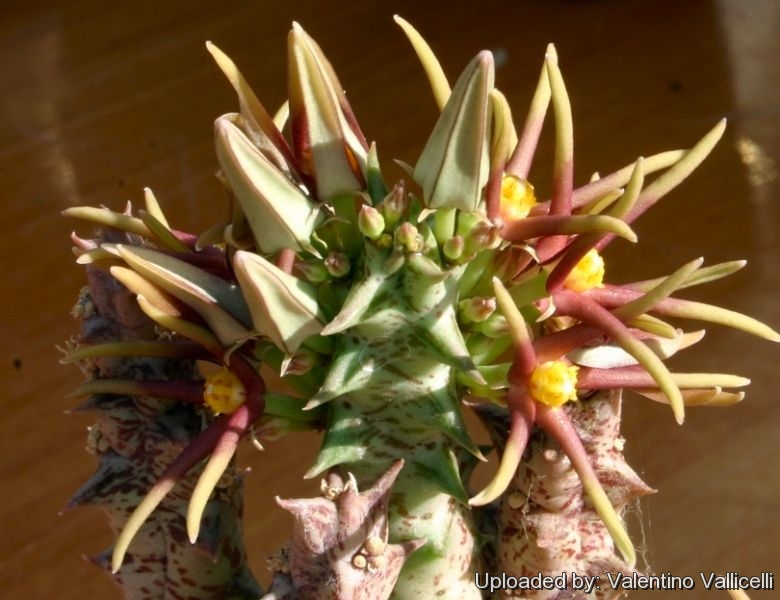
Pachycymbium meintjesianum (Caralluma meintjesiana) Photo by: Valentino Vallicelli
GAH 8155 Yemen. This psecies produces lots of yellow/red fowers with long, thin, tubular petals. The stems are nicely mottled
Origin and Habitat: Saudi Arabia, Yemen, Oman.
Altitude: This species occurs at high elevations (c. 2000-2800 metres above sea level)
Habitat: It grows in semidesert regions in rock fissures along with other succulents like as: Euphorbia fruticosaSN|14979]]SN|14979]] and Aloe vacillansSN|31643]]SN|31643]]. Caralluma meintjesianaSN|794]]SN|794]] is camuflaged down to minutest detail and at the first glance quite similar to the background.
Synonyms:
See all synonyms of Orbea wissmannii
back
Accepted name in llifle Database:Orbea wissmannii (O.Schwartz) BruynsAloe 37(4): 76. 2000Synonymy: 16
back
Description: Caralluma meintjesianaSN|794]]SN|794]] (now transferred to Orbea wissmanii by Bruyns) is a low clumping succulent species that spread over the ground forming large cushions. Flowers are five-pointed fleshy stars produced in late Summer or Autumn.
Stems: Soft, erect or ascending, rooting from the bases, 4-angled, with conical teeth along each angle. Surface smooth, light green, grey-green or dark green mottled with brownish or purple.
Flowers: Numerous, subapical, 1 to 3 (rarely more) in short inflorescences. Star-shaped about 2 cm in diameter. Corolla lobes narrow, almost linear, mostly light green with a blood red centre but very variable in colour.
Blooming season: Produces numerous flowers simultaneously in late summer to autumn. Flowers exude an intense smell of cat urine. This perfume attracts blow flies which are the natural pollinators. Following successful pollination of flowers pairs of seed horns are produced, packed with seeds attached to silky parachutes.
More...Subspecies, varieties, forms and cultivars of plants belonging to the Orbea wissmannii group
 Caralluma meintjesiana Lavranos: (= Orbea wissmannii) Flowers are fleshy stars with 5 narrow, linear lobes, mostly light green with a blood red centre but very variable. Distribution: Saudi Arabia, Yemen, Oman.
Caralluma meintjesiana Lavranos: (= Orbea wissmannii) Flowers are fleshy stars with 5 narrow, linear lobes, mostly light green with a blood red centre but very variable. Distribution: Saudi Arabia, Yemen, Oman.  Orbea wissmannii (O.Schwartz) Bruyns: Corolla lobes 12-20 mm long and more than 3 mm wide, strongly curved to touch each other behind lobe and lobes convex adaxially; yellow more or less suffused with red or red becoming paler toward apex, glabrous or covered with short papillae; corona 3-4 mm tall x 3-4 mm in diameter.
Orbea wissmannii (O.Schwartz) Bruyns: Corolla lobes 12-20 mm long and more than 3 mm wide, strongly curved to touch each other behind lobe and lobes convex adaxially; yellow more or less suffused with red or red becoming paler toward apex, glabrous or covered with short papillae; corona 3-4 mm tall x 3-4 mm in diameter.- Orbea wissmannii var. eremastrum (O.Schwartz) Bruyns: Corolla lobes 12-20 mm long and more than 3 mm wide, slightly folded back and lobes lightly convex adaxially; yellow suffused with red (sometime flesh-coloured) in proximal half, greenish yellow to yellow towards tip, glabrous or covered with short papillae; corona 3-4 mm tall x 3-4 mm in diameter.
 Orbea wissmannii var. parviloba Bruyns: Corolla lobes 9-10 mm long and less than 2 mm wide, pale yellow, covered with white hairs. Corona 1.5-2 mm tall,2.5 mm in diameter. Distribution: Yemen.
Orbea wissmannii var. parviloba Bruyns: Corolla lobes 9-10 mm long and less than 2 mm wide, pale yellow, covered with white hairs. Corona 1.5-2 mm tall,2.5 mm in diameter. Distribution: Yemen.
Bibliography: Major references and further lectures
1) S.A. Ghazanfar, M. Fisher “Vegetation of the Arabian Peninsula” Springer, 31/Aug/1998
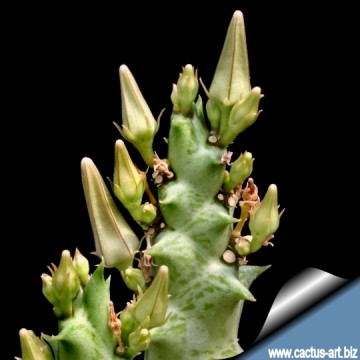 Pachycymbium meintjesianum (Caralluma meintjesiana) Photo by: Cactus Art
Pachycymbium meintjesianum (Caralluma meintjesiana) Photo by: Cactus Art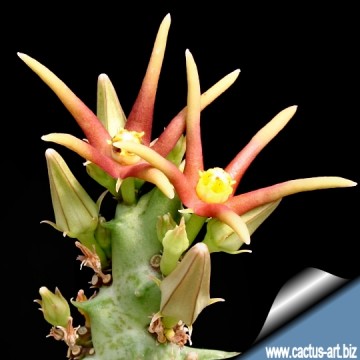 Pachycymbium meintjesianum (Caralluma meintjesiana) Photo by: Cactus Art
Pachycymbium meintjesianum (Caralluma meintjesiana) Photo by: Cactus Art Pachycymbium meintjesianum (Caralluma meintjesiana) Photo by: Cactus Art
Pachycymbium meintjesianum (Caralluma meintjesiana) Photo by: Cactus Art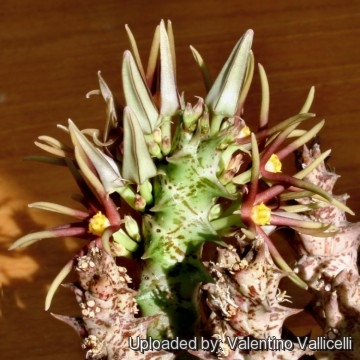 Pachycymbium meintjesianum (Caralluma meintjesiana) Photo by: Valentino Vallicelli
Pachycymbium meintjesianum (Caralluma meintjesiana) Photo by: Valentino Vallicelli Pachycymbium meintjesianum (Caralluma meintjesiana) Photo by: Cactus Art
Pachycymbium meintjesianum (Caralluma meintjesiana) Photo by: Cactus Art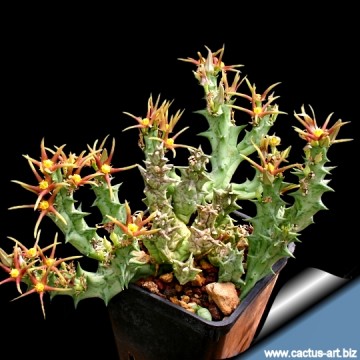 Pachycymbium meintjesianum (Caralluma meintjesiana) Photo by: Cactus Art
Pachycymbium meintjesianum (Caralluma meintjesiana) Photo by: Cactus ArtCultivation and Propagation: Caralluma meintjesianaSN|794]]SN|794]] (= Orbea wissmanniiSN|796]]SN|796]]) is an easy blooming plant when mature that require moderately watering through the growing season but enjoy plenty of water and some fertiliser in hot weather, this helps them to flower freely. Water more sparingly in winter according to temperatures. But, as with most asclepiads, it is unwise to leave them wet in cold weather. Winter care presents no problems at 5°C with plenty of light. Since roots are quite shallow, use a cactus mix or add extra perlite or pumice to regular soil potting soil. A gritty, very free-draining compost is suitable, and clay pots help the plants to dry out between watering.
Sun Exposure: Partial sun or light shade
Pest and diseases: Orbeas vary in their susceptibility to rotting, but are generally fairly easy to grow, especially if kept pest-free. They are very susceptible to stem and root mealy bugs, and damage from these may well initiate fungal attack. If you do have problems with a stem or with basal rotting, you can reliably isolate the healthy parts, dry them off, and re-root them in moist compost.
Cultural Practices: Re-pot every 2 years
Propagation: Easiest with stem cuttings. Allow cuttings to dry a day before planting. Stems must be laid (Not buried) on gritty compost and will then root from the underside of the stems. It can also be increased from seeds sowing in spring in moist, sandy peat moss.
Potting medium: Since roots are quite shallow, use a cactus mix or add extra perlite or pumice to regular soil potting soil. A gritty, very free-draining compost is suitable, and clay pots help the plants to dry out between watering.
More...

















